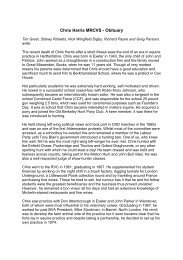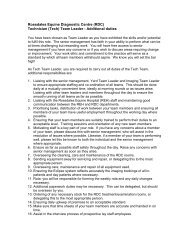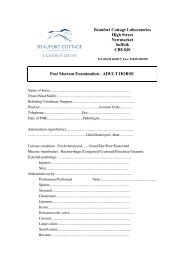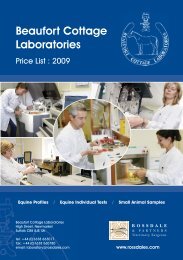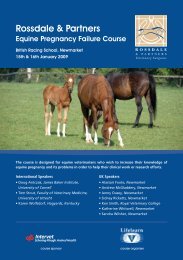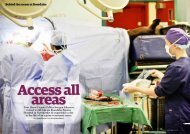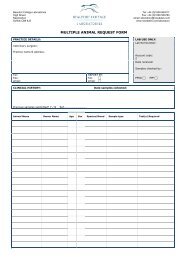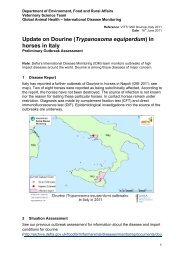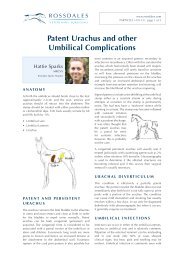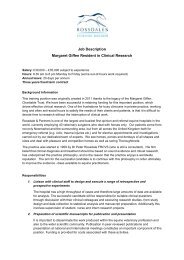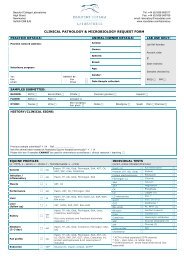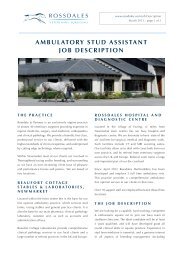EQUINE CLINICAL PATHOLOGY - Rossdale & Partners
EQUINE CLINICAL PATHOLOGY - Rossdale & Partners
EQUINE CLINICAL PATHOLOGY - Rossdale & Partners
Create successful ePaper yourself
Turn your PDF publications into a flip-book with our unique Google optimized e-Paper software.
G u i d e t o e q u i n e c l i n i c a l p a t h o l o g y<br />
■ LD isoenzyme 2 - elevated in some<br />
cases of cardiac pathology, an indication<br />
for cardiac troponin assay (see below)<br />
(Fig.13).<br />
■ LD isoenzyme 3 – no known disease<br />
association in the horse.<br />
■ LD isoenzyme 4 - most commonly<br />
elevated by intestinal pathology (Fig.14).<br />
■ LD isoenzyme 5 - rises seen with<br />
skeletal myopathy and hepatopathy,<br />
requiring further differentiation with CK<br />
(see page 24) and liver enzyme (see<br />
pages 24-28) assays (Fig.15).<br />
Total LD levels are age-dependent to<br />
maturity and reference ranges must be<br />
consulted when interpreting results for<br />
young horses (see pages 56-69).<br />
Cardiac Troponin (cTnI)<br />
Two proteins (tropomyosin and troponin)<br />
working in concert with calcium, regulate<br />
muscle contraction. Troponin is a globular<br />
protein complex composed of three<br />
single chain polypeptide subunits: TnI<br />
(troponin inhibitory component), which<br />
prevents muscle contractions in the<br />
absence of calcium; TnT (tropomyosinbinding<br />
component), which connects<br />
the troponin complex with tropomyosin;<br />
and TnC (calcium binding component),<br />
which binds calcium. The cardiac musclespecific<br />
isoform cTnI (24 kDa) exhibits<br />
approximately 60% homology with the<br />
skeletal isoforms (sTnI) and has a unique<br />
31 amino acid extension of the N-terminus.<br />
Experience in human medicine has shown<br />
that after acute myocardial infarction<br />
(AMI), elevated cTnI levels appear in the<br />
circulation within 3-6 hours. Serum levels<br />
peak within 14-20 hours and return to<br />
normal after 5-7 days. The measurement<br />
of cTnI can therefore be a useful diagnostic<br />
aid for AMI and an aid for the monitoring<br />
of recovery.<br />
Myocardial infarction is rarely diagnosed in<br />
the horse but myocardial necrosis is seen in<br />
conditions such as atypical myoglobinuria.<br />
Myocarditis is sometimes suspected on the<br />
basis of arrhythmias, echocardiographic<br />
abnormalities and/or raised serum lactate<br />
dehydrogenase isoenzyme 2 levels. This<br />
can follow upper respiratory viral infections.<br />
Horses who have suffered in this way will<br />
need more rest and supportive treatment<br />
followed by follow-up to normality before<br />
return to strenuous exercise if potentially<br />
serious complications are to be avoided.<br />
Raised cTnI levels are an indication for<br />
cardiac ultrasound examinations and<br />
ambulatory ECG monitoring.<br />
25



